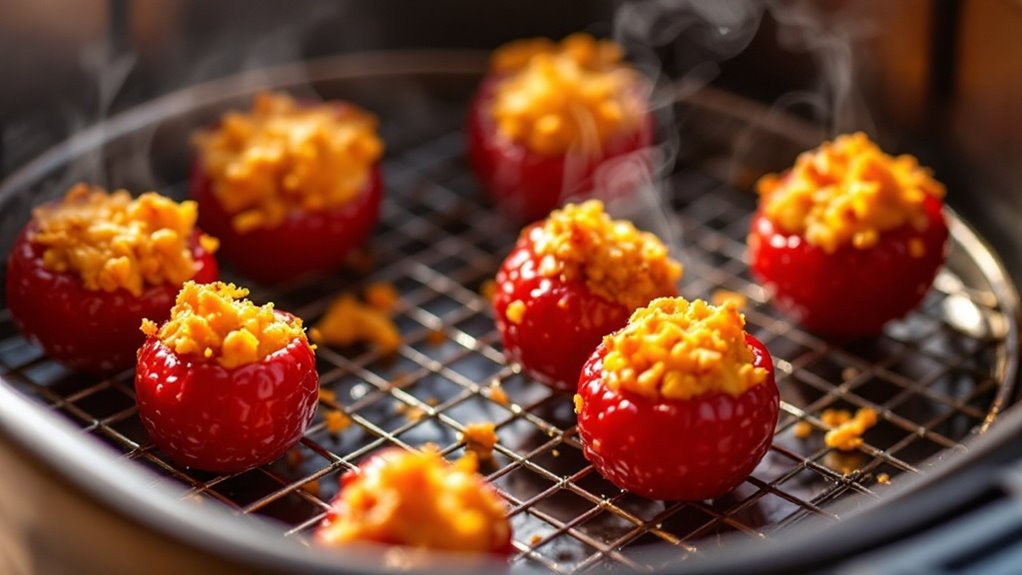You might think silicone molds are the ultimate kitchen multitaskers, capable of surviving anything from the freezer to the depths of your air fryer. But before you toss them in, you'll need to take into account a few critical factors—like heat resistance, proper placement, and whether your molds can handle the intense airflow. What happens if you ignore these details? The answer might surprise you, and it could change how you approach air frying forever. Stick around to uncover the dos and don'ts that could make or break your next culinary experiment.
Key Takeaways
- Yes, silicone molds can be used in air fryers if they are heat-resistant and rated for temperatures up to 400°F–450°F.
- Ensure the mold fits properly in the air fryer basket, leaving space for airflow to prevent uneven cooking.
- Use only food-grade silicone molds to avoid harmful chemicals and ensure safety during high-temperature cooking.
- Avoid direct contact with heating elements and position molds to allow proper air circulation for even cooking.
- Regularly inspect molds for damage, such as discoloration or brittleness, and replace if signs of thermal degradation appear.
Understanding Silicone Mold Heat Resistance
Silicone molds are heat-resistant, but their tolerance varies depending on the quality and type of silicone used. When selecting a mold for air fryer use, check its maximum temperature rating, typically listed by the manufacturer. High-quality food-grade silicone can withstand temperatures up to 500°F (260°C), but cheaper options may degrade or release harmful chemicals at lower heat levels. Always verify the mold's material safety by looking for FDA-approved or food-safe certifications. Silicone durability testing guarantees the material won't warp, crack, or leach toxins under high heat. Avoid using molds with fillers or additives, as they may compromise heat resistance. Prioritize molds designed for baking or high-temperature applications to confirm they're safe for air fryer use. Proper care and inspection extend their lifespan and maintain safety.
Temperature Limits for Air Fryer Use
Check your silicone mold's maximum safe temperature rating, typically between 400°F and 450°F, to guarantee it aligns with your air fryer's heat settings. Exceeding this limit can compromise the mold's integrity or release harmful chemicals. Always verify your air fryer's temperature range and adjust settings to stay within the mold's heat resistance threshold for safe use.
Maximum Safe Temperature
When using silicone molds in an air fryer, it's crucial to verify they can withstand the appliance's high temperatures. Most air fryers operate between 300°F and 400°F, so check your mold's maximum safe temperature rating, typically found on the packaging or manufacturer's website. Exceeding this limit can cause thermal degradation, weakening the silicone and potentially releasing harmful chemicals. Additionally, rapid material expansion at high temperatures may deform the mold, compromising its shape and functionality. Always preheat your air fryer gradually to minimize stress on the silicone. If your mold lacks a clear temperature rating, avoid using it in the air fryer to prevent safety risks. Prioritize molds labeled as heat-resistant and specifically designed for high-temperature cooking to guarantee durability and safety.
Material Heat Resistance
Since air fryers typically reach temperatures between 300°F and 400°F, you'll need to make sure your silicone molds can handle these heat levels without degrading. High-quality silicone is known for its durability, often withstanding temperatures up to 450°F or higher, but always check the manufacturer's specifications. Inferior silicone may warp, discolor, or release odors when exposed to high heat, compromising both safety and performance. Silicone's thermal conductivity guarantees even heat distribution, which is ideal for air frying, but it also means the material must maintain structural integrity under prolonged exposure. Avoid using molds with fillers or low-grade silicone, as they're more prone to failure. Prioritize food-grade, heat-resistant silicone to confirm your molds remain stable and safe during air frying.
Air Fryer Settings Impact
While air fryers offer versatile cooking options, it's crucial to understand how their temperature settings impact silicone molds. Most air fryers operate between 175°F and 400°F, but silicone molds typically withstand up to 428°F. To avoid damage, set your air fryer below this limit. Use temperature control tips like preheating to guarantee even cooking and prevent overheating. Adjust cooking time adjustments based on the recipe and mold size—smaller molds may require less time. Avoid placing molds directly under the heating element to prevent localized overheating. Always monitor the air fryer during use, as silicone can warp or discolor if exposed to excessive heat. Following these guidelines secures safe, effective use of silicone molds in your air fryer.
Choosing the Right Silicone Mold Size
To guarantee your silicone molds work effectively in an air fryer, you'll need to select a size that fits comfortably within the basket without obstructing airflow. Mold size selection is critical for air fryer compatibility, as overcrowding can lead to uneven cooking or damage to the appliance. Measure your air fryer basket's dimensions and choose molds that leave at least an inch of space around the edges. Avoid tall or wide molds that block the heating element or fan. Opt for smaller, flexible molds that allow hot air to circulate freely. Check the mold's heat resistance rating to confirm it can withstand your air fryer's temperature range. Proper sizing guarantees efficient cooking and prevents safety hazards like overheating or melting.
Proper Placement in the Air Fryer Basket
When placing silicone molds in your air fryer basket, make sure they're positioned to allow maximum airflow around and beneath them. Proper basket spacing guarantees even cooking and prevents hot air from being blocked, which could lead to uneven results. Arrange molds so they don't touch each other or the basket walls, leaving at least an inch of space between them. For mold positioning, place them in a single layer and avoid stacking, as this restricts airflow and may cause undercooking. If your molds are small, consider using a trivet or rack to elevate them slightly, improving circulation underneath. Always check the manufacturer's guidelines for your air fryer's capacity and avoid overcrowding. Proper placement not only enhances cooking performance but also secures safety and prevents damage to your molds or appliance.
Avoiding Direct Contact With Heating Elements
Silicone molds must never come into direct contact with the air fryer's heating elements, as this can cause melting, warping, or even a fire hazard. Always maintain sufficient heating element distance by placing the mold in the center of the basket, away from the top or sides where heating coils are located. Use the air fryer's rack or a heat-safe trivet to elevate the mold if necessary, guaranteeing mold positioning safety. Avoid overfilling the mold, as rising batter or liquids could touch the heating elements. Double-check the mold's placement before starting the air fryer to prevent accidental contact. Following these precautions guarantees your silicone molds remain intact and safe during cooking.
Best Foods to Cook in Silicone Molds
Although silicone molds are versatile, they're particularly well-suited for baking and cooking foods that require even heat distribution and easy release. Their mold flexibility makes them ideal for delicate items like mini quiches, muffins, and custards, which benefit from consistent heat and gentle handling. You can also use them for air-frying foods like egg bites, stuffed peppers, or even small cakes, as the molds' non-stick properties guarantee food release ease without sticking or tearing. Avoid overfilling the molds to prevent spills and secure proper airflow in the air fryer. Always check that the molds are heat-resistant and rated for air fryer use to avoid melting or warping. By choosing the right foods, you'll maximize the molds' efficiency and maintain their longevity.
Cleaning and Maintaining Silicone Molds
To keep your silicone molds in top condition, clean them thoroughly after each use to prevent residue buildup and odors. Use warm, soapy water and a soft sponge or cloth for effective mold cleaning techniques. Avoid abrasive scrubbers, as they can damage the silicone surface. For stubborn stains, soak the molds in a mixture of baking soda and water before gently scrubbing. Rinse well and air-dry completely to prevent moisture retention. Proper silicone maintenance methods include storing molds flat or rolled, not folded, to avoid creases. Keep them away from sharp objects and direct heat sources, which can degrade the material. Regularly inspect for cracks or tears, as damaged molds can compromise food safety. Following these steps guarantees durability and peak performance.
Safety Tips for Air Fryer Silicone Use
Always check your silicone mold's heat resistance rating to make sure it can withstand your air fryer's maximum temperature. Place the mold securely in the basket, avoiding contact with heating elements to prevent melting or warping. Clean and inspect the mold regularly for damage, as cracks or wear can compromise its safety during use.
Heat Resistance Limits
When using silicone molds in an air fryer, it's crucial to check their heat resistance rating, as most silicone products can withstand temperatures up to 428°F (220°C). Exceeding these heat tolerance levels can lead to thermal degradation risks, such as warping, melting, or releasing harmful chemicals. Always verify the manufacturer's specified temperature limit, typically printed on the mold or packaging. Avoid using molds with unclear ratings or those not explicitly labeled as heat-resistant. High-quality, food-grade silicone is your safest bet, as it's designed to handle intense heat without compromising safety. If you notice discoloration, brittleness, or a strange odor, stop using the mold immediately, as these are signs of thermal damage. Prioritize safety by adhering to the recommended heat limits.
Proper Placement Guidelines
Since air fryers rely on rapid air circulation, you'll want to position silicone molds carefully to guarantee even cooking and prevent accidents. Follow these mold placement tips: always center the mold in the basket to allow proper airflow around it. Avoid overcrowding by leaving space between multiple molds or other items. Make sure the mold doesn't touch the heating element or basket walls, as this can cause uneven heating or damage. For air fryer positioning, place the mold on a flat, stable surface within the basket to prevent tipping during cooking. If using smaller molds, consider securing them with a silicone mat or liner to keep them steady. Proper placement guarantees efficient cooking and reduces the risk of spills or burns. Always double-check positioning before starting the air fryer.
Cleaning and Maintenance Tips
To guarantee your silicone molds remain safe and functional for air fryer use, clean them thoroughly after each cooking session. Use warm, soapy water and a soft sponge to remove food residue, avoiding abrasive scrubbers that can damage the surface. For stubborn stains, soak the molds in a baking soda solution before gently scrubbing. Always air-dry them completely to prevent moisture buildup, which can lead to mold growth. Store molds flat or rolled, avoiding sharp folds that may cause cracks. Regularly inspect for signs of wear, such as discoloration or tears, and replace damaged molds to maintain safety. These mold cleaning techniques and maintenance best practices secure longevity and prevent contamination, keeping your air fryer silicone molds in peak condition for repeated use.
Disclosure: As an Amazon Associate, I earn from qualifying purchases.


